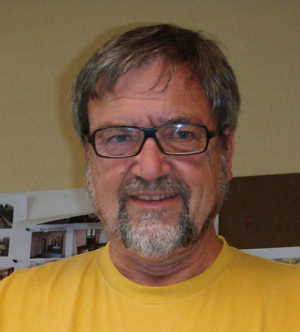Biography
Götz Weidner was born in Berlin on December 12, 1942, to a film journalist and an art painter. After a few years in Frankfurt, the family moved to Munich in 1956, where his father became press manager at the film distributor Constantin Filmverleih. At high school, an art teacher recognized Götz Weidner's talent and entrusted the teenager with drawing theater sets and stage designs. After graduating from high school, Weidner completed an internship at Munich's Bavaria Film at the age of 18 - originally with the goal of attending the art academy afterwards to become a stage designer for theater. But things turned out differently. Weidner discovered the world of film for himself and stayed at Bavaria, where he trained as a production designer from 1962 to 1966. In 1966, he was involved in the production of the special effects for the television series "Raumpatrouille Orion" under the direction of Rolf Zehetbauer and together with the special effects artist Theo Nischwitz.
In 1970, Weidner began working as a freelance film architect, initially primarily for television series such as "Graf Yoster gibt sich die Ehre" (1974) and "Derrick" (1974-1976). He frequently worked with director Franz Peter Wirth, among others on the two-parter "Die Marquise von B." (1970) and on the four-part film biography "Wallenstein" (1978). Weidner's big breakthrough came with Wolfgang Petersen's global success "Das Boot" ("The Boat", 1981), on which he again worked with Rolf Zehetbauer. In the years that followed, he became one of the most renowned and sought-after production designers in German film.
Among Weidner's best-known works of the 1980s are Peter Zadek's satire "Die wilden Fünfziger" ("The Roaring Fifties", 1983), Petersen's fantasy adventure "Die unendliche Geschichte" ("The Neverending Story", 1984, with Johann Kott and Herbert Strabel) and the TV mini-series "Väter und Söhne" ("Fathers and Sons: A German Tragedy", DE/IT/AT 1985) and "Hemingway" (DE/FR/IT/US 1987), both directed by Bernhard Sinkel. For "Väter und Söhne" Weidner was awarded the CableACE Award (USA) in 1988 together with Erhard Engel.
In the first half of the 1990s, Weidner worked on such different films as the comedy "Go, Trabi, Go" (1990), the fantasy sequel "Die unendliche Geschichte II - Auf der Suche nach Phantasien" ("The Neverending Story II: The Next Chapter", 1990), the social satire "Schtonk!" (1992) and the police thriller "Die Sieger" ("The Invincibles", 1993). For television, he worked on several episodes of the crime series "Polizeiruf 110" and Dieter Wedel's highly acclaimed mini-series "Der König von St. Pauli" (1998), among others.
With the Hollywood film "U-571" (US/FR 2000), Götz Weidner worked once again on a submarine film set in World War II, which – just like "Das Boot" - was also praised not least for its realistic set design. For Heinrich Breloer's TV three-parter "Die Manns - Ein Jahrhundertroman" ("The Manns - Novel of a Century", which won several awards, he faithfully recreated Thomas Mann's Munich villa, which was destroyed during the war. The production design for the multi-part TV series "Das Wunder von Lengede" ("A Light in Dark Places", 2003, directed by Kaspar Heidelbach), about the mining accident at the town of Lengede in 1963, earned him the Bavarian Television Award. Weidner received a nomination for the German Television Award for his work on Breloer's "Speer und Er" ("Speer & Hitler: The Devil's Architect", 2005). In 2006, Götz Weidner again collaborated with Heidelbach on the filming of the sinking of the "Pamir," a sail training ship. Götz Weidner was awarded the Bavarian Film Prize for the production design in Breloer's lavish cinema production "Buddenbrooks" (2008).
After Kaspar Heidelbach's feature film "Berlin '36" (2009), which told the story of the Jewish Olympic high jumper Gretl Bergmann, Weidner, who was 67 at the time, started to work less. In the next few years, he was responsible for the production designs of the nuclear accident drama "Restrisiko" (2011, TV) and the film biography "Egon Schiele - Tod und Mädchen" ("Egon Schiele: Death and the Maiden", AT/LU 2016). Director Joseph Vilsmaier was able to lure Weidner out of his semi-retirement in 2019 to create the set design for his fairy-tale romance "Der Boandlkramer und die ewige Liebe."
